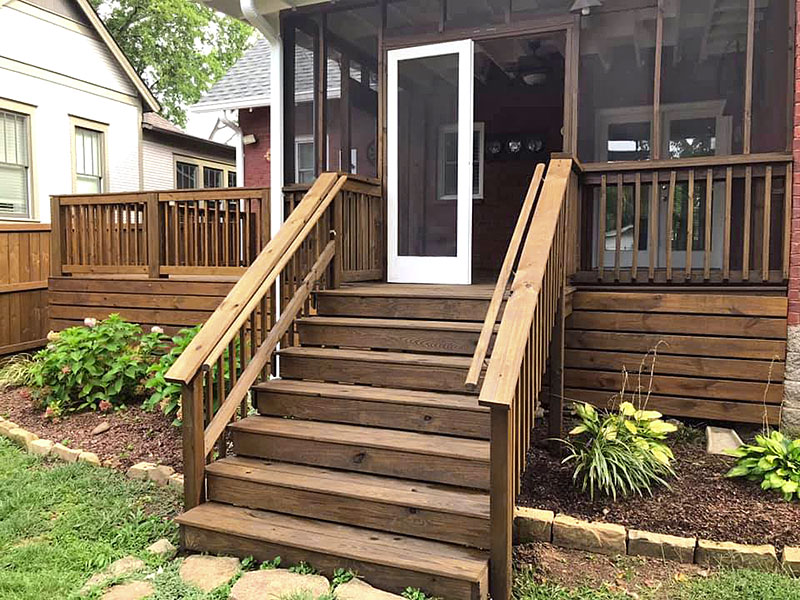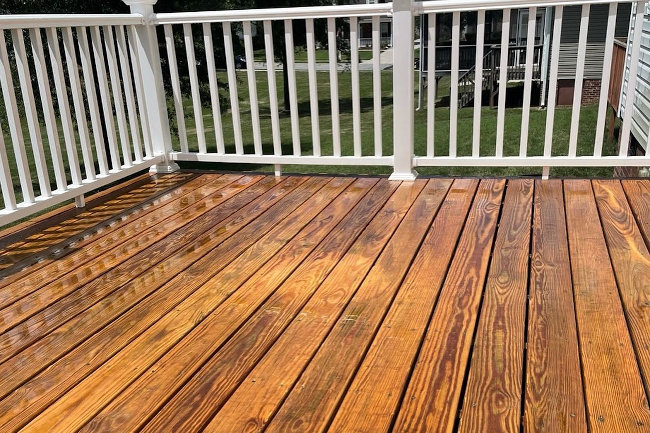Stain Deck for a Resilient Complete: Tips and Techniques
Stain Deck for a Resilient Complete: Tips and Techniques
Blog Article
A Comprehensive Overview to Different Kinds of Deck Staining Techniques for Ultimate Security and Aesthetics
In the world of deck maintenance, the art of discoloring stands as an essential action in the direction of both preserving the honesty of your outdoor space and improving its aesthetic appeal. As we navigate through the complex world of deck discoloration methods, one begins to value the nuanced methods that can make all the difference in between a sub-par surface and a flawless one.
Recognizing Various Types of Stains
Various types of spots are generally made use of in the procedure of deck staining to achieve various visual and protective effects. On the other hand, semi-transparent stains offer an equilibrium in between shade improvement and defense, permitting some wood grain to show through.
Toners add a hint of shade to the timber while supplying minimal protection, making them appropriate for newer decks with less wear. Recognizing the characteristics and advantages of each kind of stain is important for accomplishing the wanted appearance and sturdiness for your deck.
Choosing the Right Stain Shade
When considering the looks of your deck staining task, the selection of discolor color plays a crucial role in improving the protective qualities of the selected discolor type (Beautiful Deck). The shade you select can considerably influence the overall appearance of your deck, in addition to its capability to stand up to the elements gradually
When choosing a discolor shade, it's vital to take into consideration the existing color pattern of your home's exterior. Balancing the deck tarnish with the overall visual of your property can create a cohesive and visually enticing exterior area. Additionally, the color of your deck stain can influence the temperature of the deck surface; darker colors tend to take in even more heat, while lighter colors show sunshine and stay cooler.
Additionally, the sort of timber you are staining will additionally influence how the tarnish shade shows up. Various wood varieties can connect with the tarnish in numerous means, possibly modifying the final color. It's recommended to test the tarnish on a little, low-profile location of the deck to ensure the color ends up as desired prior to waging the entire job.
Preparing Your Deck for Staining
To make sure a lasting and successful deck staining job, detailed preparation of the deck surface is important. Begin by cleaning up the deck thoroughly to get rid of dirt, gunk, mold, and any type of old complete or discolor.
Examine the deck for any kind of damaged or rotten boards that need to be changed. Hammer down any protruding nails and sand any type of harsh locations to guarantee a smooth surface area for staining. Look for any kind of loosened railings or actions that may require tightening up or repair work.
Once the deck is clean, dry, and in great repair service, think about applying a wood brightener to recover the deck's natural shade and open up the timber pores for better tarnish infiltration. Protect any type of nearby plants, furniture, or surface areas with plastic sheeting prior to continuing with the discoloration procedure. Correct preparation is essential to attaining a professional-looking coating and making the most of the long life of your deck stain.
Applying Discoloration With Numerous Strategies
For a professional and perfect coating, the method of using discolor plays an essential role in boosting the look and resilience of your deck. There are numerous methods you can utilize to guarantee a reliable application of stain.
Cleaning is a traditional technique that allows for precision and control over the quantity of stain applied. It is optimal for complex locations and reaching between deck boards (Chicago Deck Staining). Rolling is a quicker alternative, covering larger surface efficiently. Nonetheless, back-brushing after rolling is advised to also out the stain and function it into the timber for much better infiltration.
Splashing is an additional prominent weblink technique, providing speed and simplicity of application, specifically for huge deck locations. It is essential to make use of a top quality sprayer and bear in mind overspray. Pad applicators provide a smooth and also end up and are appropriate for both straight and upright surfaces. Whichever strategy you choose, ensuring appropriate prep work and complying with producer standards will certainly assist attain a long-lasting and gorgeous discolor coating on your deck.

Maintaining and Re-staining Your Deck
Proper maintenance and timely re-staining are necessary for maintaining the elegance and durability of your deck. Regular upkeep jobs consist of sweeping particles, cleaning up with a deck cleaner, and examining for any kind of signs of wear or damage. Resolving problems quickly can prevent more significant problems in the future. When it involves re-staining your deck, the frequency relies on numerous aspects such as the kind of discolor utilized, the environment in your area, and just how much deterioration your deck experiences. Normally, it is advised to re-stain your deck every 2-4 years to maintain its protection and looks.
Prior to re-staining, make sure the deck is clean, dry, and free of any type of previous discolor deposit. Choose a high-grade tarnish that matches your deck's material and offers the preferred level of protection.
Final Thought
In conclusion, comprehending the different types of deck stains, picking the ideal shade, correctly preparing the deck, using tarnish with various methods, and re-staining the deck and keeping are important steps for best defense and appearances. By following these steps, you can guarantee that your deck remains in top problem for many years to find.
Additionally, the shade of your deck stain can affect the temperature of the deck surface; darker colors often tend to take in more heat, while lighter shades mirror sunlight and remain cooler.
It's a good idea to examine the tarnish on a little, unnoticeable area of the deck to make sure the shade turns out as wanted before continuing with the whole project.

Report this page